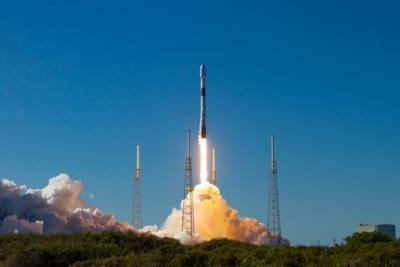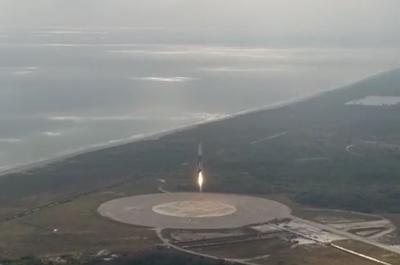There and Back Again: a Booster’s Tale
On Monday, 12 June 2023, Space Exploration Technologies Corporation—colloquially, SpaceX—landed its 200th rocket-booster. The milestone achievement occurred just eight-minutes after the 14:35 PDT launch of the company’s Transporter-8 rideshare mission from Space Launch Complex 4E at California’s Vandenberg Space Force Base (VSFB).

Borne aloft by a SpaceX Falcon-9 rocket, the mission delivered 72 payloads ranging in size from picosatellites massing less than one-kilogram to orbital platforms massing several hundred kilograms into Sun-Synchronous Orbits (SSO) of approximately 525-kilometer altitudes and 97.5-degree inclinations.
Certainly the strangest payload delivered to orbit by the Transporter-8 mission was a small satellite sponsored by the Vatican. Dubbed Spei Satelles—Latin for satellites of hope—the breadbox-sized contraption contained a chip engraved with a speech delivered by Pope Francis during the COVID-19 exigency.
Transporter-8 marked a turning-point in Falcon-9 rideshare missions insomuch as it was the first such endeavor to utilize SpaceX’s modular Rideshare Plates to accommodate the aforementioned payloads.
Transporter-8 occasioned 2023’s 40th Falcon mission and followed the launch of a gaggle of Starlink satellites earlier in the day from Space Launch Complex 40 at Florida’s Cape Canaveral Space Force Station (CCSFS).
The Transporter missions are intended to provide a consistent cadence of rideshare opportunities to popular orbits—such as SSO. Currently, one additional Transporter mission is slated for 2023.
While some Transporter customers arrange space-launch services for their payloads by dealing directly with SpaceX, most payloads are booked through launch integrators—entities that purchase capacity on a given mission’s payload stack, then assemble multiple customers into subject capacity. Thereafter, the payloads deploy either directly from the launch adapter or onboard a separable deployer or space tug by which they’re released at a later time.
The record-setting 200th booster landed at SpaceX’s Landing Zone (LZ) 4 in Lompoc, California at 14:42 PDT. The occurrence marked the space-launch concern’s 126th consecutive successful booster landing and evinced the maturation of myriad fiddly technologies.

In 2015, the first successful landing of a SpaceX booster dazzled the world. The feat evoked memories of classic science-fiction properties the likes of Flash Gordon and the 1959 Twilight Zone episode titled The Lonely, in which a convict serving out fifty-years of solitary confinement on a habitable asteroid is visited by police come calling in a majestic rocket that descends and touches-down vertically.
In the years since, SpaceX has improved its landing capabilities to such an extent that the vast majority of the sixty-plus boosters the company launched in 2022 were previously flown.
As a rocket’s first-stage boosters account for upwards of ninety-percent of its overall price-tag, reusability dramatically drives down the cost of space-launches. By reusing boosters, SpaceX has contemporaneously lowered the cost and upped the frequency of safe and reliable space-launches—thereby largely democratizing the formerly oligopolistic commercial space industry.
 ANN's Daily Aero-Term (10.26.25): Hazardous Weather Information
ANN's Daily Aero-Term (10.26.25): Hazardous Weather Information ANN's Daily Aero-Linx (10.26.25)
ANN's Daily Aero-Linx (10.26.25) Aero-News: Quote of the Day (10.26.25)
Aero-News: Quote of the Day (10.26.25) Classic Aero-TV: Of Rotors, Ribs, World Records, and a Growing Phenomenon
Classic Aero-TV: Of Rotors, Ribs, World Records, and a Growing Phenomenon NTSB Prelim: Toop Thomas A Glasair Super II FT
NTSB Prelim: Toop Thomas A Glasair Super II FT




